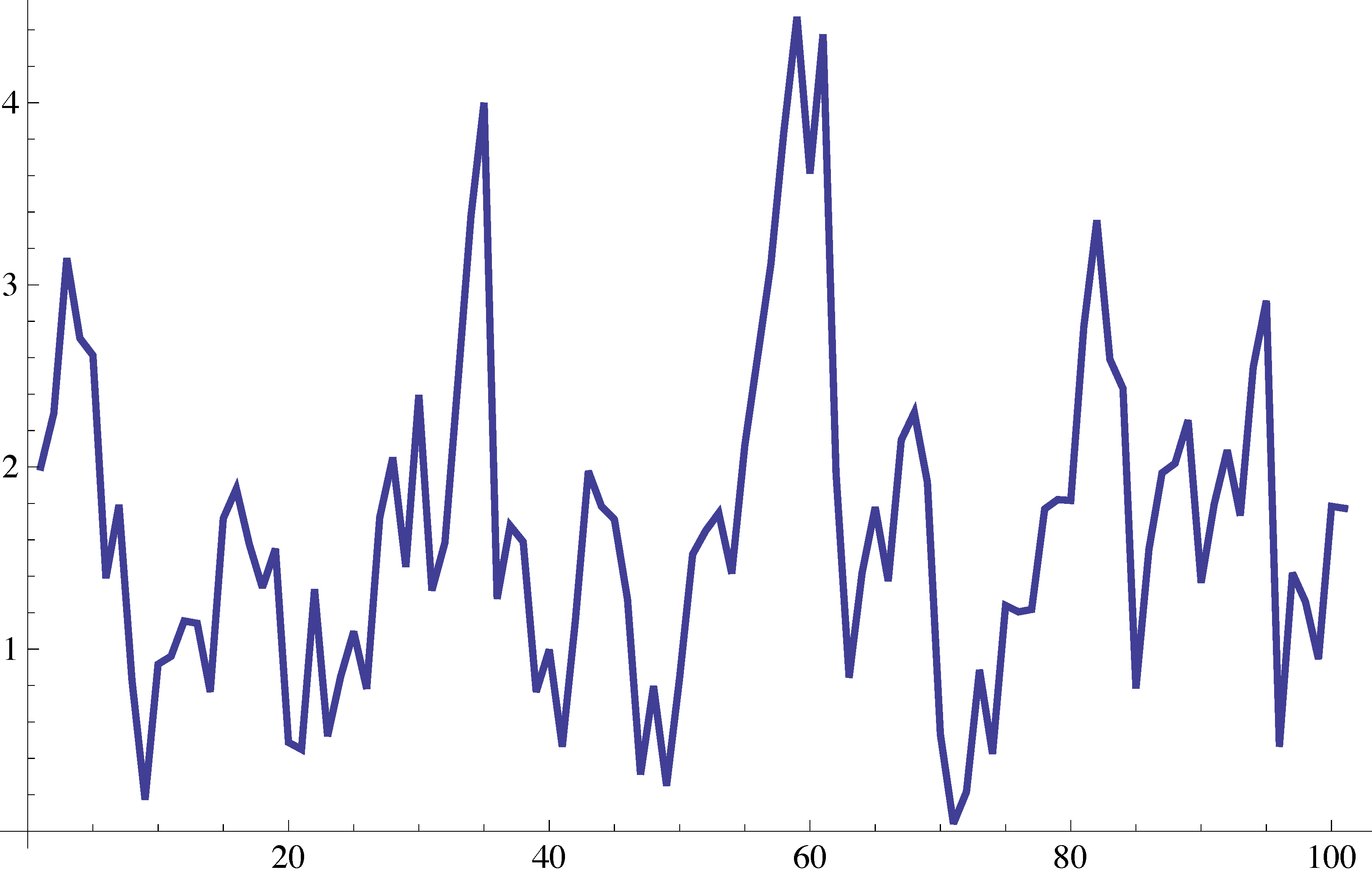Recurrence and rates of convergence
You will get more from the exercises by trying them before looking at the solutions!
- Recall that the total variation distance between two probability distributions \(\mu\) and \(\nu\) on \(\mathcal{X}\) is given by \[\text{dist}_{\text{TV}}(\mu, \nu) \;=\; \sup_{A \subseteq \mathcal{X}}\{\mu(A)-\nu(A)\}\,.\] Show that this is equivalent to the distance (note the absolute value signs!) \[\sup_{A \subseteq \mathcal{X}}|\mu(A)-\nu(A)|\,.\]
Hint: Consider \(A^c\).
Solution: If \(A\subseteq \mathcal{X}\) then \(A^c \subseteq\mathcal{X}\). And if \(\pi(A)-\nu(A)\) is negative, then \(\pi(A^c)-\nu(A^c)\) is positive, since \[\pi(A^c)-\nu(A^c) = 1-\pi(A) - (1-\nu(A)) = \nu(A)-\pi(A).\] Thus the supremum of \(\pi(A)-\nu(A)\) over all subsets \(A\) of \(\mathcal X\) is always achieved when \(\pi(A)-\nu(A)\) is positive.
- Show that if \(\mathcal{X}\) is discrete, then
\[\text{dist}_{\text{TV}}(\mu, \nu) = \tfrac12 \sum_{y\in\text{X}}|\mu(y)-\nu(y)|\,.\]
(Here we do need to use the absolute value on the RHS!)
Hint: consider \(A=\{y: \mu(y)>\nu(y)\}\).
Further hint: Show that for \(A\) as above and any \(B\subseteq\mathcal{X}\), we have \(\mu(B)-\nu(B)\le \mu(A)-\nu(A)\), and \(\nu(B)-\mu(B)\le \nu(A^c)-\mu(A^c)\).
Solution: As in the hints, note that since \(\mu(y)-\nu(y)>0\) for all \(y\in A\) and \(\nu(y)-\mu(y)\ge 0\) for all \(y\in A^c\), \[\mu(B)-\nu(B) = \sum_{y\in B}(\mu(y)-\nu(y)) \le \sum_{y\in A\cap B} (\mu(y)-\nu(y)) \le \sum_{y\in A} (\mu(y)-\nu(y)) = \mu(A)-\nu(A).\] and similarly, \[\nu(B)-\mu(B)\le \nu(A^c) - \mu(A^c).\] Thus \[\sup_{B \subseteq \mathcal{X}}\{\mu(B)-\nu(B)\} = \mu(A)-\nu(A),\] and by question 1 above we also have \[\sup_{B\subseteq \mathcal{X}}\{\mu(B)-\nu(B)\} = \sup_{B\subseteq \mathcal{X}}|\mu(B)-\nu(B)| = \sup_{B\subseteq \mathcal{X}}\{\nu(B)-\mu(B)\} = \nu(A^c)-\mu(A^c).\] Therefore, averaging the two lines above, \[\sup_{B \subseteq \mathcal{X}}\{\mu(B)-\nu(B)\} = \frac{1}{2}(\mu(A)-\nu(A)+\nu(A^c)-\mu(A^c))\] and since every \(y\in\mathcal{X}\) is in exactly one of \(A\) or \(A^c\), this equals \[\frac{1}{2}\sum_{y\in\mathcal{X}}|\mu(y)-\nu(y)|.\]
Suppose now that \(\mu\) and \(\nu\) are density functions on \(\mathbb{R}\). Show that \[\text{dist}_{\text{TV}}(\mu, \nu) = 1 - \int_{-\infty}^\infty \min\{\mu(y),\nu(y)\} dy \,.\] Hint: remember that \(|\mu-\nu| = \mu+\nu - 2\min\{\mu,\nu\}\).
Consider a Markov chain \(X\) with continuous transition density kernel. Show that it possesses many small sets of lag 1.
Hint: Suppose the transition density kernel of \(X\) is \(p:\mathbb{R}\times\mathbb{R}\to [0,\infty)\). For any \(x\in\mathbb{R}\), there must be some \(y\in\mathbb{R}\) such that \(p(x,y)>0\), and then since \(p\) is continuous, there must be \(\varepsilon>0\) such that \(p(x',y')>p(x,y)/2\) for all \(x'\in [x-\varepsilon,x+\varepsilon]\) and \(y'\in[y-\varepsilon,y+\varepsilon]\). Use these objects to create \(E\), \(\alpha\) and \(\nu\).
Solution: Fix \(x\in\mathbb{R}\) and then \(\varepsilon>0\) as in the hint. Let \(E=[x-\varepsilon,x+\varepsilon]\), and \(\alpha = \varepsilon p(x,y)\). Finally let \(\nu\) be uniform on \([y-\varepsilon,y+\varepsilon]\).
For any \(x'\in E\) and \(A\subset\mathbb{R}\), \[\begin{align*} \operatorname{\mathbb{P}}\left(X_{1}\in A | X_0 = x'\right) = \int_A p(x',y') dy' &\ge \int_{A\cap[y-\varepsilon,y+\varepsilon]} p(x',y') dy' \\ &\ge \int_{A\cap[y-\varepsilon,y+\varepsilon]} \frac{p(x,y)}{2} dy'\\ &= \varepsilon p(x,y) \int_{A\cap[y-\varepsilon,y+\varepsilon]} \frac{1}{2\varepsilon} dy'\\ &= \alpha \nu(A). \end{align*}\]
Thus \(E\) is a small set. Since we can do this for any \(x\in\mathbb{R}\), and we can choose \(\varepsilon>0\) arbitrarily small, we can create arbitrarily many such small sets.
- Consider a Vervaat perpetuity \(X\), where \[X_0=0; \qquad X_{n+1} = U_{n+1}(X_n+1) \,,\] and where \(U_1,U_2,\dots\) are independent Uniform\((0,1)\) (simulated below).

Find a small set for this chain.
Solution: There are many possible answers. Here is one: let \(E = [0,1]\), \(\alpha = 1/2\) and \(\nu\) be uniform on \([0,1]\). Let \(U\) be a uniform random variable on \([0,1]\). Then for any \(x\in E\) and \(A\subset[0,\infty)\), \[\begin{align*} \operatorname{\mathbb{P}}\left(X_{1}\in A | X_0 = x\right) = \operatorname{\mathbb{P}}\left(U(x+1)\in A\right) &= \int_{A\cap[0,x+1]} \frac{1}{x+1} dy \\ &\ge \frac{1}{2} \int_{A\cap[0,1]} dy = \frac{1}{2}\nu(A). \end{align*}\] So \(E\) is small.
- Recall the idea of regenerating when our chain hits a small set: suppose that \(C\) is a small set for a \(\phi\)-irreducible chain \(X\), i.e. for \(x \in C\),
\[\operatorname{\mathbb{P}}\left(X_1\in A| X_0=x\right) \geq \alpha \nu(A).\]
Suppose that \(X_n\in C\). Then with probability \(\alpha\) let \(X_{n+1} \sim \nu\), and otherwise let it have transition distribution
\(\tfrac{p(x,\cdot)-\alpha\nu(\cdot)}{1-\alpha}\).
- Check that the latter expression really gives a probability distribution.
- Check that \(X_{n+1}\) constructed in this manner obeys the correct transition distribution from \(X_n\).
- Define a reflected random walk as follows: \(X_{n+1}=\max\{X_n+Z_{n+1},0\},\) for \(Z_1, Z_2, \ldots\) i.i.d. with continuous density \(f(z)\), \[ \operatorname{\mathbb{E}}\left[Z_{1}\right]<0 \quad\text{and}\quad \operatorname{\mathbb{P}}\left(Z_{1}>0\right)>0 \,. \] Show that the Foster-Lyapunov criterion for positive recurrence holds, using \(\Lambda(x)=x\).
Hint: Choose \(c\in(0,\infty)\) such that \(\operatorname{\mathbb{P}}\left(Z_1\le -c\right) > 0\) and \(\operatorname{\mathbb{E}}\left[Z_1\operatorname{\mathbf{1}}_{Z_1>-c}\right]<0\). (To see that there exists such a \(c\), let \[\tilde c = \sup\{x\in\mathbb{R} : \operatorname{\mathbb{P}}\left(Z_1\le -x\right)>0\} \in (0,\infty].\] Then since \(Z_1\) has a density, \(\operatorname{\mathbb{E}}\left[Z_1\operatorname{\mathbf{1}}_{Z_1>-\tilde c}\right]=\operatorname{\mathbb{E}}\left[Z_1\right]<0\), so \(\lim_{x\uparrow\tilde c}\operatorname{\mathbb{E}}\left[Z_1\operatorname{\mathbf{1}}_{Z_1>-x}\right]=\operatorname{\mathbb{E}}\left[Z_1\right]<0\) and \(\operatorname{\mathbb{P}}\left(Z_1\le -c\right)>0\) for all \(c < \tilde c\).) Then show that \(\{x: \Lambda(x)\le c\}\) is small.
Solution: Take \(c\) as in the hint. First we show that \(\{x: \Lambda(x)\le c\} = [0,c]\) is a small set. Let \(\nu = \delta_0\), the delta mass at \(0\), and \(\alpha = \operatorname{\mathbb{P}}\left(Z_1\le -c\right)\). Then for \(x\in[0,c]\), \[\operatorname{\mathbb{P}}\left(X_1\in A | X_0 = x\right) \ge \operatorname{\mathbf{1}}_{0\in A} \operatorname{\mathbb{P}}\left(X_1 = 0 | X_0 = x\right) \ge \operatorname{\mathbf{1}}_{0\in A}\operatorname{\mathbb{P}}\left(Z_1\le -c\right) = \alpha \nu(A),\] so indeed \([0,c]\) is small.
Then we have \[\operatorname{\mathbb{E}}\left[\Lambda(X_{n+1}) | \mathcal{F}_n\right] = \operatorname{\mathbb{E}}\left[X_{n+1} | \mathcal{F}_n\right] = \int_{-X_n}^\infty (X_n + z) f(z) dz \le X_n + \int_{-X_n}^\infty z f(z) dz.\] If \(X_n\not\in C\), i.e. \(X_n>c\), then this is smaller than \(X_n - \int_{-c}^\infty z f(z) dz\) and we have chosen \(c\) such that \(\int_{-c}^\infty z f(z) dz = \operatorname{\mathbb{E}}\left[Z_1\operatorname{\mathbf{1}}_{Z_1>-c}\right]<0\). Thus we can set \(a=-\operatorname{\mathbb{E}}\left[Z_1\operatorname{\mathbf{1}}_{Z_1>-c}\right]\).
On the other hand, if \(X_n\in C\), then \[\operatorname{\mathbb{E}}\left[\Lambda(X_{n+1}) | \mathcal{F}_n\right] \le X_n + \int_{-X_n}^\infty z f(z) dz \le X_n + \int_0^\infty z f(z) dz\] so we can choose \(b=a+\int_0^\infty z f(z) dz\). Thus we have shown that \(X\) satisfies the Foster-Lyapunov criterion for positive recurrence.